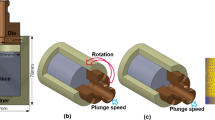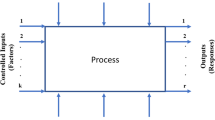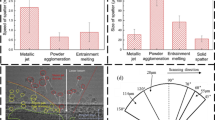Abstract
In the laser keyhole welding process, one ray can have several reflections and absorptions during the process. This is called multiple-reflection and is considered to be one of the important physical phenomena in the laser keyhole welding process. To calculate the multiple-reflection in laser keyhole welding simulations, a ‘Ray tracing’ methodology is used. Through ray tracing, several ray properties, such as the current location of a ray, the location of reflection, and the reflected direction, can be calculated. This study investigated the numerical simulations of two ray tracing methods, the Direct Search Method (DSM) and Progressive Search Method (PSM). There are differences between the two ray tracing methods. PSM uses a real equation for the surface and ray direction vector while DSM uses a discriminant. A reflected ray is moved step by step in PSM, but only once by the discriminant in DSM. The reflected ray starts from the real contact point in PSM, but from the center of the contacted sub-cell in DSM. PSM can depict the multi-path of the ray by employing a set of sub-rays concept. On the other hand, DSM cannot depict the multi-path of the ray, because it uses a single ray definition. Therefore, PSM is a more physical numerical method and can depict various phenomena, such as transmission and scattering. PSM has a higher accuracy in laser keyhole welding simulations. In PSM, two new models were applied, the transmission and scattering models. All simulations were performed with the computational fluid dynamics (CFD) method including the volume of fluid (VOF) technique. Simulations using the DSM and PSM were performed to compare these two methods.

















Similar content being viewed by others
References
Cho JH, Na SJ (2006) Implementation of real-time multiple reflection and Fresnel absorption of laser beam in keyhole. J Phys D Appl Phys 39(24):5372
Cho JH, Na SJ (2007) Theoretical analysis of keyhole dynamics in polarized laser drilling. J Phys D Appl Phys 40(24):7638
Cho JH, Na SJ (2009) Three-dimensional analysis of molten pool in GMA-laser hybrid welding. Weld J 88(2):35–43
Seto N, Katayama S, Matsunawa A (2000) High-speed simultaneous observation of plasma and keyhole behavior during high power CO2 laser welding: effect of shielding gas on porosity formation. J Laser Appl 12(6):245–250
Kaplan A (1994) A model of deep penetration laser welding based on calculation of the keyhole profile. J Phys D Appl Phys 27(9):1805
Allmen MV, Blatter A (1995) Laser-beam interactions with materials, 2nd edn. Springer
Sahoo P, DebRoy T, McNallan MJ (1988) Surface tension of binary metal—surface active solute systems under conditions relevant to welding metallurgy. Metall Trans B 19(3):483–491
Katayama S, Kawahito Y, Mizutani M (2010) Elucidation of laser welding phenomena and factors affecting weld penetration and welding defects. Phys Procedia 5:9–17
Cho WI, Na SJ, Thomy C, Vollertsen F (2012) Numerical simulation of molten pool dynamics in high power disk laser welding. J Mater Process Technol 212(1):262–275
Cho WI, Na SJ, Cho MH, Lee JS (2010) Numerical study of alloying element distribution in CO 2 laser–GMA hybrid welding. Comput Mater Sci 49(4):792–800
Cho YT, Cho WI, Na SJ (2011) Numerical analysis of hybrid plasma generated by Nd: YAG laser and gas tungsten arc. Opt Laser Technol 43(3):711–720
Ahn J, Na SJ (2013) Three-dimensional thermal simulation of nanosecond laser ablation for semitransparent material. Appl Surf Sci 283:115–127
Hirt CW, Nichols BD (1981) Volume of fluid (VOF) method for the dynamics of free boundaries. J Comput Phys 39(1):201–225
Youngs DL (1982) Time-dependent multi-material flow with large fluid distortion. Numer Methods Fluid Dyn 24:273–285
Yang P, Liou KN (2009) Effective refractive index for determining ray propagation in an absorbing dielectric particle. J Quant Spectrosc Radiat Transf 110(4):300–306
Park KW, Na SJ (2010) Theoretical investigations on multiple-reflection and Rayleigh absorption–emission–scattering effects in laser drilling. Appl Surf Sci 256(8):2392–2399
Bohren CF, Huffman DR (2008) Absorption and scattering of light by small particles. Wiley
Henyey LG, Greenstein JL (1941) Diffuse radiation in the galaxy. Astrophys J 93:70–83
Binzoni T, Leung TS, Gandjbakhche AH, Rüfenacht D, Delpy DT (2006) The use of the Henyey–Greenstein phase function in Monte Carlo simulations in biomedical optics. Phys Med Biol 51(17):N313
Kattawar GW (1975) A three-parameter analytic phase function for multiple scattering calculations. J Quant Spectrosc Radiat Transf 15(9):839–849
Acknowledgments
Support by the Brain Korea 21 and Mid-career Researcher Program through NRF of Korea (Grant No. 2013R1A2A1A01015605) is appreciated.
Author information
Authors and Affiliations
Corresponding author
Additional information
Recommended for publication by Commission XII - Arc Welding Processes and Production Systems
Rights and permissions
About this article
Cite this article
Han, SW., Ahn, J. & Na, SJ. A study on ray tracing method for CFD simulations of laser keyhole welding: progressive search method. Weld World 60, 247–258 (2016). https://doi.org/10.1007/s40194-015-0289-1
Received:
Accepted:
Published:
Issue Date:
DOI: https://doi.org/10.1007/s40194-015-0289-1




